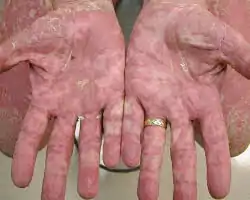Thymoma-associated multiorgan autoimmunity
Thymoma-associated multiorgan autoimmunity (TAMA) is a severe often fatal disease that presents in some patients with thymoma.[1] It has also been referred to in the medical literature as "thymoma-associated graft-versus-host-like disease".
| Thymoma-associated multiorgan autoimmunity (TAMA) | |
|---|---|
 |
Presentation
Patients with TAMA present with variable combinations of a morbilliform skin eruption, chronic diarrhea, and abnormal liver enzymes. The histopathology of the skin, liver, or bowel mucosa resembles GVHD.[2]
Pathophysiology
Thymoma is a common neoplasm arising from the thymus, the primary lymphoid organ where T cells become educated to distinguish "self" from "non self". In the setting of thymoma, abnormal thymic education occurs as a result of subtle differences in antigen processing. In TAMA these differences result in autoreactive T cells escaping from the thymus. This results in a condition similar to graft-versus-host disease.[1]
Treatment
Patients often have a refractory disease course but some patients may respond to phototherapy.[3]
History
This disease name was coined by Emanual Maverakis and described in detail in 2007 but case reports of graft-versus-host-like disease in the setting of thymoma date back to at least the mid 1990s.[1][4]
References
- Wadhera A, Maverakis E, Mitsiades N, Lara PN, Fung MA, Lynch PJ (Oct 2007). "Thymoma-associated multiorgan autoimmunity: a graft-versus-host-like disease". J Am Acad Dermatol. 57 (4): 683–9. doi:10.1016/j.jaad.2007.02.027. PMID 17433850.
- Meneshian A, Giaccone G, Olivier KR. "Clinical presentation and management of thymoma and thymic carcinoma". UpToDate.
- Nakayama M, Itoh M, Kikuchi S, Tanito K, Nakagawa H (Apr 2016). "Thymoma-associated cutaneous graft-versus-host-like disease possibly treated with Narrow-band UVB phototherapy". Eur J Dermatol. 26 (2): 208–9. doi:10.1684/ejd.2015.2716. PMID 27018042. S2CID 26959211.
- Kornacki S, Hansen FC, Lazenby A (1995). "Graft-versus-host-like colitis associated with malignant thymoma". Am J Surg Pathol. 19 (2): 224–8. doi:10.1097/00000478-199502000-00011. PMID 7832281.